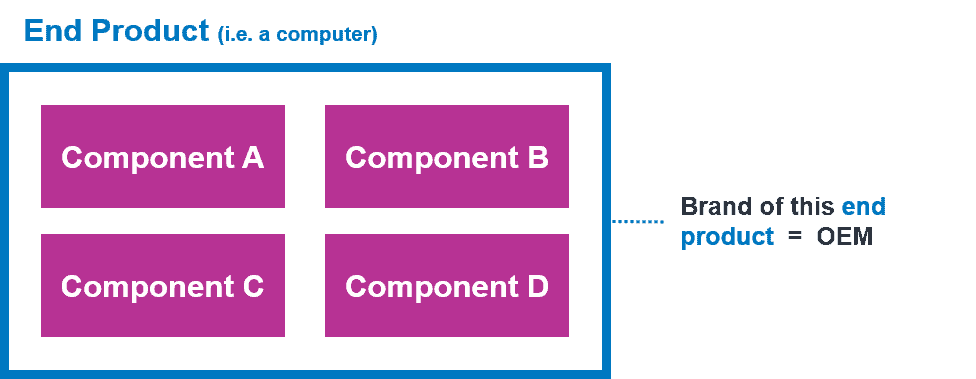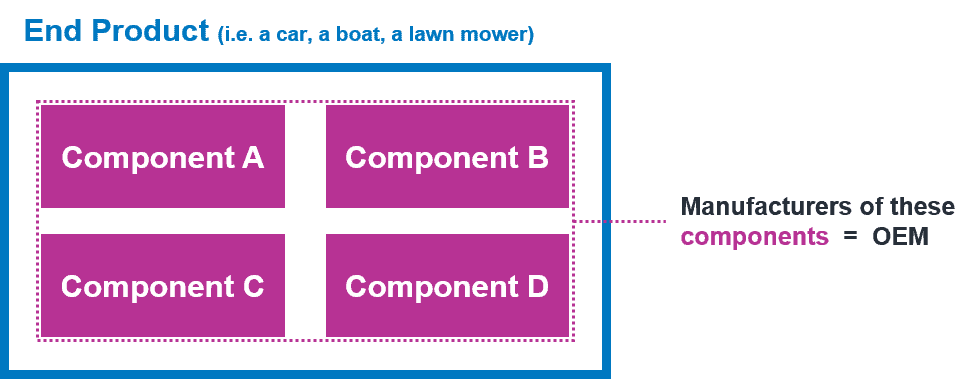OEM stands for Original Equipment Manufacturer. It’s actually a very easy term to understand. However, people often use the OEM term in several different and sometimes conflicting ways. This causes ambiguity and confusion. In this article, we’ll walk you through what OEM is in a very simple and easy to understand manner. People generally use the term Original Equipment Manufacturer (OEM) in three ways.
First OEM Meaning
First, OEM serves as a noun and means the manufacturer of components that make up the end product. For example, a car is an end product that has many different components. It has the engine, cooling system, fuel tanks, air filters, brakes, tires, etc. While brands, such as Toyota, BMW, Mercedes, and Ferrari, manufacture some components that go inside a car themselves, they don’t manufacture all the components. Instead, they rely on other companies that may specialize in manufacturing certain components.
In other words, different manufacturers produce these components and sell to car companies such as Toyota, BMW, Mercedes, Ferrari. These car companies then “assemble” these components together to produce a car under their brand. But while the car may have the Toyota / BMW / Mercedes / Ferrari brand, other manufacturers produced the components inside that car. These other manufacturers that produced the original equipment are called “Original Equipment Manufacturer” or OEM.
The need for the term OEM arises because while a car may be branded under one particular logo (i.e. a Lamborghini car), the components inside that car are actually manufactured by other companies. Hence, there’s a need for the term OEM to reference these manufacturers of the original equipment.
The key idea here is that while an item may belong to a brand, some other manufacturers likely manufactured the things inside that item. This phenomenon is very common in commerce. The manufacturers of these things are called “Original Equipment Manufacturers”.
First Meaning Example
Cars.com writes the following regarding OEM.
“The term relates to any company that manufactures parts for use in new vehicles. OEMs make a wide variety of components and hardware, such as exhaust systems, brakes, glass and electrical parts. Better known examples of OEMs are companies like ACDelco, which makes components used in the manufacture of new GM vehicles, and Motorcraft, which performs a similar role for Ford.”
The usage of the term here fits into our first definition.
Second OEM Meaning
Second, OEM serves as a noun and means the brand of the end product. For example, just like a car, a computer has many different components. It has the motherboard, the central processing unit (CPU), random access memory (RAM), graphics card, sound card, etc. While computer brands, such as Dell, Microsoft, HP, and Lenovo, manufacture some components that go inside a computer themselves, they don’t manufacture all the components. For example, many of these brands’ computers use Intel for CPU and NVIDIA for graphics card.
While companies like Intel, NVIDIA, AMD, and GeForce produce the things that go inside a computer, the computers are branded under Dell, HP, Lenovo, etc. In this case, the computer is the end product that consumers purchase. In the second OEM use case, it refers to the brands of the end product, which are Dell, HP, Lenovo, etc.
At this point, if you feel like this second meaning conflicts with the first meaning, you are correct. The second meaning is in direct contradiction to the first use case. Remember how we said earlier that people use the OEM term in several different and sometimes conflicting ways? This is it! Both cars and computers have components that go inside them. In one situation, it refers to the manufacturers of the components that make up an end product (cars). In another situation, it means the brand of the end product (computers) instead of the manufacturers of the components.

Second Meaning Example
PC Magazine writes the following regarding OEM.
“Many of the largest PC vendors are OEMs, including HP, Dell and Lenovo. Essentially, any PC company that does not have its own manufacturing facilities is an OEM. The OEM often does not add anything to the equipment and merely brands it with its own logo.”
The usage of the term here fits into our second definition. As you can see, this second definition is in direct conflict with the first. Unfortunately, people use the term to mean both. You have to rely on context and clarifications in order to confirm what someone means when they say OEM.
Third OEM Meaning
Third, OEM serves as an adjective. It can mean being the same components as the original ones that came with the end product. It can also mean being manufactured by the manufacturer of the original components that came with the end product.
The owner of an end product often needs to replace components or parts within that end product. This is especially the case when the end product is an expensive item, such as a car or an airplane. For example, if you get into a car accident, it’s likely that you’ll need to replace some car components. When you shop for the replacement, you can choose between “OEM” and “Aftermarket”.
You’ll often hear people say “OEM parts”. That means parts that are either the original ones that came with the end product or ones manufactured by the same manufacturer. By contrast, “aftermarket parts” means parts that differ from the original ones or not made by the original manufacturer. OEM parts often fit perfectly with the end product and are more reliable than aftermarket parts. As a result, they are usually more expensive than aftermarket parts.
Third Meaning Example
Car Windshields writes the following regarding OEM and aftermarket parts.
“While OEM windshields can restore the default factory safety measures of the car against the harsh outside environment and flying debris, aftermarket windshields can also do the same, but sometimes either better or worse, depending on the quality of the materials. However, if you opt for the OEM alternative, there is already an assurance that the safety level you’ll get is the same as when you first bought the vehicle, and they meet the manufacturer’s safety standard. On the other hand, aftermarket glasses can’t guarantee safety because it depends on the different manufacturers’ standards.”
The usage of the term here fits into our third definition.
Financial & Investment Analysis
OEM is a term that you’ll commonly encounter in financial and investment analysis. This is especially the case if you’re analyzing the industrial or technology hardware sectors. Company filings, investor presentations and equity research reports often mention the OEM term for these sectors due to its strategic importance. We wrote this article after struggling with the fluidity of the usage of OEM. We found that OEM usage in one report is logically contradictory with the usage in another report. Hence, we hope this article can clear the air for you.
If you would like to learn more about our financial and investment analysis classes, please check out our curriculum and sign up here.
